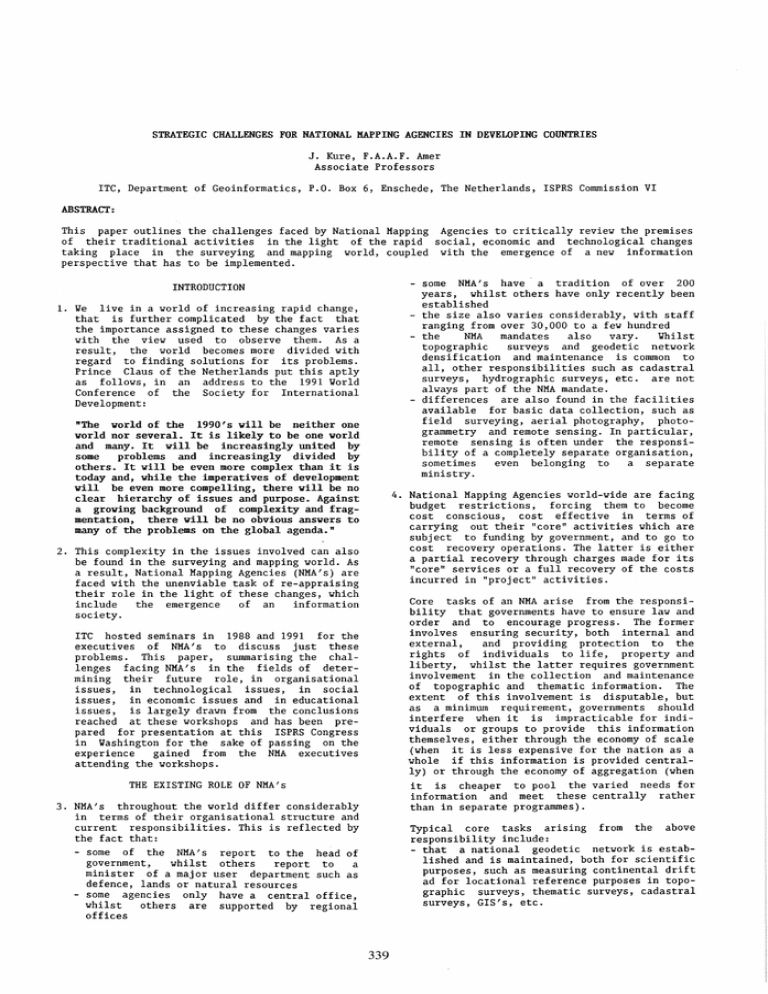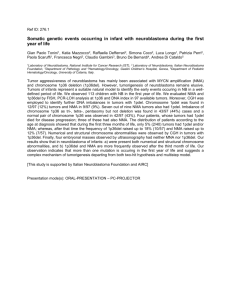STRATEGIC CHALLENGES FOR NATIONAL HAPPING ... J.
advertisement

STRATEGIC CHALLENGES FOR NATIONAL HAPPING AGENCIES IN DEVELOPING COUNTRIES J. Kure, F.A.A.F. Amer Associate Professors lTC, Department of Geoinformatics, P.O. Box 6, Enschede, The Netherlands, ISPRS Commission VI ABSTRACT: This paper outlines the challenges faced by National Mapping Agencies to critically review the premises of their traditional activities in the light of the rapid social, economic and technological changes taking place in the surveying and mapping world, coupled with the emergence of a new information perspective that has to be implemented. - some NMA's have a tradition of over 200 years, whilst others have only recently been established - the size also varies considerably, with staff ranging from over 30,000 to a few hundred the NMA mandates also vary. Vhilst topographic surveys and geodetic network densification and maintenance is common to all, other responsibilities such as cadastral surveys, hydrographic surveys, etc. are not always part of the NMA mandate. - differences are also found in the facilities available for basic data collection, such as field surveying, aerial photography, photogrammetry and remote sensing. In particular, remote sensing is often under the responsibility of a completely separate organisation, sometimes even belonging to a separate ministry. INTRODUCTION 1. Ve live in a world of increasing rapid change, that is further complicated by the fact that the importance assigned to these changes varies with the view used to observe them. As a result, the world becomes more divided with regard to finding solutions for its problems. Prince Claus of the Netherlands put this aptly as follows, in an address to the 1991 Vorld Conference of the Society for International Development: "The world of the 1990's will be neither one world nor several. It is likely to be one world and many. It will be increasingly united by some problems and increasingly divided by others. It will be even more complex than it is today and, while the imperatives of development will be even more compelling, there will be no clear hierarchy of issues and purpose. Against a growing background of complexity and fragmentation, there will be no obvious answers to many of the problems on the global agenda." 4. National Mapping Agencies world-wide are facing budget restrictions, forcing them to become cost conscious, cost effective in terms of carrying out their "core" activities which are subject to funding by government, and to go to cost recovery operations. The latter is either a partial recovery through charges made for its "core" services or a full recovery of the costs incurred in "project" activities. 2. This complexity in the issues involved can also be found in the surveying and mapping world. As a result, National Mapping Agencies (NMA's) are faced with the unenviable task of re-appraising their role in the light of these changes, which include the emergence of an information society. Core tasks of an NMA arise from the responsibility that governments have to ensure law and order and to encourage progress. The former involves ensuring security, both internal and external, and providing protection to the rights of individuals to life, property and liberty, whilst the latter requires government involvement in the collection and maintenance of topographic and thematic information. The extent of this involvement is disputable, but as a mlnlmum requirereent, governments should interfere when it is impracticable for individuals or groups to provide this information themselves, either through the economy of scale (when it is less expensive for the nation as a whole if this information is provided centrally) or through the economy of aggregation (when it is cheaper to pool the varied needs for information and meet these centrally rather than in separate programmes). ITC hosted seminars in 1988 and 1991 for the executives of NMA's to discuss just these problems. This paper, summarising the challenges facing NMA's in the fields of determining their future role, in organisational issues, in technological issues, in social issues, in economic issues and in educational issues, is largely drawn from the conclusions reached at these workshops and has been prepared for presentation at this ISPRS Congress in Vashington for the sake of passing on the experience gained from the NMA executives attending the workshops. THE EXISTING ROLE OF NMA's 3. NMA's throughout the world differ considerably in terms of their organisational structure and current responsibilities. This is reflected by the fact that: - some of the NMA's report to the head of government, whilst others report to a minister of a major user department such as defence, lands or natural resources - some agencies only have a central office, whilst others are supported by regional offices Typical core tasks arising from the above responsibility include: - that a national geodetic network is established and is maintained, both for scientific purposes, such as measuring continental drift ad for locational reference purposes in topographic surveys, thematic surveys, cadastral surveys, GIS's, etc. 339 - that a topographic map series or a series of digital topographic databases is produced and maintained for multi-purpose use such as exploration and exploitation of natural resources; urban, regional and rural developme~t; .engineering ap~lications; securityappllcatlons of the mllitary, the police and th~ fire brigades; thematic surveys such as sOlIs, forestry, geology, etc.; recreation; tourism; environmental monitoring; etc. - that cadastral maps and plans are produced and are maintained for land registration purposes, so as to be able to regulate the equitable distribution of land, control its optimal use, avoid land disputes and promote the development of land by the land owner himself, who is able to raise money for this on the basis of the security offered by the land titles. - that aeronautical and hydrographic charts are produced and are kept up-to-date in order to protec~ lives in air and sea navigation operatlons. 5. The need for revenue generation introduces the requirement that NMA's look for possible extensions for their current activities. Hereby NMA's must appreciate that the essence of marketing is knowing the customer and his needs. Hence, in order to ensure a return or investments in project activities NMA's must strive to respond more promptly and effectively to requests, to reduce the cost of their operations and to improve the quality of their services by providing better information on which users can base their decisions. The scope of this system of linked data bases will unquestionably vary from country to country, in view of its dependence on the u~er requirements of a NSIS. However, a Ilnked system has the advantage that duplication of effort can be avoided in data collection, data storage and data maintenance within each individual data base, thus reSUlting in considerable savings in total costs on a national level. - if these linkages are to work, attention will have to be paid to the NSIS infrastructure and an information management model will have to be developed that will lead to: * institutional policies and standards related to data transfer, data quality, data classification, etc. * policies related to data security, * sale, licensing, copyright, etc. organisational issues such as the linkages to suppliers and users and maintaining a directory on data availability and quality, to support the retrieval and partitioning of data according to feature type and geographic location. 8. Yith regard to the very important task within a NSIS of establishing linkages between the national topo data base and other specialised data bases and developing the information management model that leads to the policy and organisation of the NSIS, this co-ordinating role could, under certain circumstances, be carried out by the NMA, if given the mandate, power and additional funding to do so and if its position within the political infrastructure permits this i.e. if the NMA reports directly to the head of government or the Ministry of Planning, which also has a coordinating role. CHALLENGES RELATING TO THE FUTURE ROLE OF NMA's YITHIN A NATIONAL INFORMATION INFRASTRUCTURE 6. Much more uniformity could be found in the perception of what the NMA's mission should be in the emerging information society. In the first place, this will be the responsibility for the geometric framework of a national GIS (or National Spatial Information System - NSIS) in the form of a national topographic data base, that acts as a central archive for GIS analyses and serves as a working data base for the production of graphics. Opinions differed, however, on whether the NMA's role should be more than this i.e. should it assume a leading role in the NSIS development by establishing linkages between the national topo data base and other specialised data bases and should it develop the information management model that regulates these linkages, the standards to be used, etc.? Another solution would be to entrust this coordinating role to a National Committee with a Permanent Secretariat and strong participation of NMA's and other geo-information supplying and using agencies reporting to the head of Government or a Central Agency. This Committee does not have production functions but is responsible for the identification and coordination of needs and production activities, development of standards and specifications in support of the gradual establishment of the geo-information infrastructure required. The Committee's role includes the development of national policies on land and resource information which promote the utmost cost effectiveness of the national geo-information infrastructure and the information. 7. The requirements of a National Spatial Information System (NSIS) were seen to be as follows: Ideally the Committee should be empowered by its professional competence and its facilitating capacity in which the interest of all is recognised. However, in some if not most jurisdictions they may require establishment by statute and having funding control to enforce coordination in geo-informatics activities. - that firstly, a geometric framework be established and maintained. This should be in the form of a control network and a national topo data base, that acts as a foundation for GIS analyses and serves as a working data base for the production of graphics. - as a next step, a minimum set of linkages has to be established between the national topo data base and other specialised data bases containing cadastral and land registration data; land use and land cover data; transportation and communication network data; census data; etc. If a mechanism such as this Committee with a sufficiently high profile is not feasible, the NMA should initiate an Inter Agency co-ordinating committee to co-operate with geo-information producing agencies in the establishment of a geo-information infrastructure. Such committees have, for example, been established in 340 system of linked data bases. This ca'n be achieved by carefully matching the design of the general and comprehensive National Data Base with what is known to exist or could be included in the small, more specialised data bases. An essential element in this matching process is the efficiency consideration of keeping the National Data Base as simple as possible in terms of the number of data items and the detaildness of data classification, this for its mUlti-purpose general use. countries such as Australia, Canada and the US. Whatever solution is adopted, it is essential that awareness be created at the political level that an information economy depends on the efficient functioning of a national information infrastructure, promoting ease of access to and use of geo-information. Different mechanisms of public and administrative policy can be employed, appropriate to different countries, to support the leadership and coordination needed to develop and implement this in the interest of economic and social development. If now specialist users are interested in more detail in data classification, the responsibility for data collection, storage and maintenance of the more specialised attribute information would be transferred to the single or main user requiring this. 9. Other general points brought up in the discussion on the role of NMA's within a national information infrastructure were: - NMA's must redefine their missions and secure adequate funding for their more demanding tasks, especially relating to the maintenance of the national topo data base. Important cost considerations in this regard are to keep the data content as simple as possible and to identify the user's requirements for currency of the data items, to link these with the data decay rates and thereby establish revision priorities for the various data items. NMA's must organise workshops to generate awareness of the technological changes taking place and of their implications. - Agencies just starting to implement digital technology should examine the possibility of attaching staff to organisations well established in this field, in order to gain experience. - Given the above mentioned NMA responsibility for the topo data base within a NSIS, there was also agreement that NMA's should introduce digital technology as soon as possible, in order gain experience and keep abreast with new developments. - As NMA's enter into the digital field they should identify at least one major user or user group that is ready to apply digital information and will thus become a strong supporter for a sustained and relevant digital production programme. CHALLENGES RELATED TO TECHNOLOGICAL DEVELOPMENTS AND THE INTRODUCTION OF MODERN TECHNOLOGY IN A NMA 11. Consideration has to be taken of the rapid technological developments occurring in the fields of expert systems, data bases, navigation systems, point positioning systems, satellite technology and image processing. These new integrated tools and techniques are either replacing or complementing established technologies in map production, but either way they are revolutionising mapping processes through their impact on the traditional disciplines involved and on how the information needs of the user community can best be served. Coupled to this is the fact that the user community is becoming accustomed to rapid response digital technology in day to day life: television, telecommunication, banking, travel and publishing. As a consequence, users will expect the same efficiency and response in the handling of geo-information, forcing national mapping agencies to deal with less patient, more knowledgeable and more critical clientele. 12. As the introduction of computer technology is a must and not an option in the information production environment, it is strongly recommended that national mapping agencies establish simple but improvable digital topo data bases nov. CHALLENGES RELATING TO ORGANISATIONAL ISSUES 10. The main organisational challenge, that of developing the national information management model and its infrastructure, has been summarised in paragraph 8 and so will not be repeated here. Other organisational challenges include: This recommendation is made in spite of the problems known, such as: - technological developments are so fast that it is difficult to decide what systems should be adopted, - new systems should only be employed when you have trained staff to operate and maintain the systems, - new systems should only be introduced when the operating environment (air conditioning, dust control, power supply) is in order. NMA's should develop clear plans for the institutional changes necessary to implement digital technology; these plans should address new function descriptions and staff development at all levels, including middle and senior management, to prepare the organisation for the implementation of the new technology. Investment plans should also be developed. 13. The type of sophistication of technology needed in geo-information production is dependent on the planning level at which the information is required. If this is at the national level, the information requirements are coarse and simple systems can be used in data collection and handling. If, however, the users are utility companies who are prepared to pay for the digital data, then more sophistication is needed in the technology used to create a large scale digital data base. - Linked to these plans should be strong indications to equipment suppliers, specifying equipment characteristics that will withstand adverse environmental conditions, and are low costilow maintenance. - Data overlaps and the duplication of effort in data collection, storage and maintenance must also be avoided when operating within a 341 with these rising and changing demands. 14. Clear plans should be developed for the institutional changes needed in order to deal with the transition from analogue to digital operations. Aspects to be taken into account in drawing up these plans include: - That the implementation of new technology takes some time to be fully effective and therefore organisations have to count on having a mixture of technology in this interim period. That the introduction of digital technology is a complex operation and it can affect NMA's in the way they relate to clients (other government organisations and the general public, who in this digital field, also have to be familiar with the technology); in the way conventional mapping units relate to each other; in the production lines and working methods; etc. These implications have to be studied carefully so that the NHA can adapt its organisational structure and can train its staff to cope with the new situation. That special attention needs to be paid to the social changes within the organisation, when going digital. Good communication is essential, since the relevance of introducing the new technology has to be explained in order to receive the necessary support at all levels. Furthermore, when the necessary changes are introduced, this should be done in small simple steps so that staff are not lost along the way. No real problems were envisaged in the conversion from an analogue to a digital data base at medium scales, since most countries have a complete coverage of 1:50,000 maps. Problems were, however, foreseen in the conversion of the old records of large scale and cadastral data bases into a digital data base. 17. The related social issue of meeting user's data quality requirements was recognised as being quite complex. It involves both data accuracy and data completeness, with far from simple models since accuracy relates to the resultant accuracy of the input errors (ground control, aerial photography and aerial triangulation), the collection errors (orientation, measurement and identification) and the storage and processing errors (rounding off; vector to raster conversion; overlay errors; etc.) whilst completeness relates to the generalisation percentage of the content; the percentage of elements required actually picked up; the correctness of the classification and the decay rate of the data items. Furthermore, in terms of its cost effectiveness, this does not concern the data quality itself, but relates rather to the extent to which this data quality meets user needs. Essentially, the client establishes the quality and timeliness as a function of what he is prepared to pay. It is thus necessary to identify the users and then carefully establish what their realistic information requirements are, depending on how they are utilising the data. This ~ttei process is therefore much easier in single purpose products such as cadastral plans, hydrographic charts, etc. than in multipurpose topo maps or data bases, with widely varying requirements, depending on user purpose and field of application. 18. NMA's are also sometimes guilty of not identifying the realistic information needs of users, with the result that the data and information gaps, due to missing or inadequate information, and the data and information overlaps, due to irrelevant information, arise. In view of the fact that both situations affect the cost effectiveness of the mapping programme, it is important to avoid these by becoming more active in identifying users information needs and going out and seeing what users are actually doing. Hereby it is also important to concentrate on the information needs themselves, rather than to look to the products which might satisfy these needs. 15. On the question of equipment, it was suggested that organisations adopt a more "active attitude" towards manufacturers. Examples given were in setting up stricter equipment specifications (equipment to withstand adverse environmental conditions and have low maintenance costs); that back-up support from manufacturers be guaranteed; that an upward compatibility of systems and components be guaranteed; etc. Furthermore, there is a requirement for representative standard data sets and effective methodologies for the evaluation of digital systems. CHALLENGES RELATING TO ECONOMIC ISSUES 19. Lack of funds to finance the implementation of digital technology was seen to be the major constraint in many countries. This implies that long term investment plans have to be drawn up and the funding bodies, whether the government or foreign aid agencies, have to be convinced of the long term benefits which will accrue from their investments. CHALLENGES RELATING TO SOCIAL ISSUES 16. The social demands for up-to-date maps and other information products are rising relentlessly under the pressure of urbanisation, the needs of resource exploitation and management, the development of agriculture, the protection of a liveable environment and the need for security and political stability. Coupled to this is the increasing complexity that can be observed in the planning and decision making process and its greater decentralisation (more and more decisions taken at the level where the development takes place), leading to a requirement for more, faster, more current and more-to-the-point information on the one hand, and to more complex types of information (interrelations between information categories, consequences of actions) on the other. The challenge facing NHA's is now how to cope 20. On the question of revenue generation, it was pointed out that NHA's traditionally have little experience in marketing their products, simply because there has been no incentive to do so, when the nominal charges made for maps do not flow back to the agency but disappear in a central treasury. Yith the budget restrictions facing NMA's world wide, the following recommendations were put forward to improve the situation: - If the NHA cannot change the situation of charges made flowing to the central 342 treasury, they should at least negotiate budget increases comparable vith their revenue earnings. - NMA's must strive to retain government funding for their core tasks (maintenance of geodetic netvork; establishment and maintenance of national topo maps/data bases; etc.) by demonstrating that these tasks fulfil a national need and therefore require funding. Hovever, since limits viII be imposed on this funding, NMA's must strive to reduce the costs of their core operations; to improve the quality of their services in all respects, but particularly timeliness and sensitivity to clients and undertake work on quantifying the benefits in providing land and resource information. The opportunities to generate extra revenue through task and product diversification are tremendous, but demands a thorough market analysis in order to get to knov the customer and his needs. Furthermore, given the fact that the current data requirements far exceed the available NMA production capacity and that this situation vill probably only vorsen, as the national and vorld economy becomes more dependent on information, it vould appear that the future challenge for NMA's viII be to meet as many of the requirements as possible through both internal and external means, vhereby the latter imply entering into production co-operation agreements vith other government agencies and the commercial sector. 21. Yith regard to cost effectiveness, it was recognised that NMA's have to develop cost models for all their operations so that quality and cost can be balanced against the requirements. Furthermore, producers will have to carefully analyse user requirements in order to establish whether these are realistic or not; users viII have to be educated so that they have a greater appreciation of mapping costs and cost variations and the producers viII have to use these cost variation figures in optimising their data collection methods. An example vas given of a cost calculation vhereby plotting costs vere found to account for 95% of the total mapping costs (mapping at 1:1000 in an area vith a very high density of detail). The implication nov in planning the mapping programme is that one can vary the project parameters to improve and simplify the mapping process, vithout substantially increasing the total costs since these are anyhov largely plotting costs. Examples of these simplifications are going to smaller and more convenient block sizes, adding more ground control than actually required to improve the reliability and using photography at larger scales than needed and possibly also colour photography, to improve the interpretability and thereby reduce the field verification effort needed. 22. The importance of keeping the maps/data bases of a National Topo Series up-to-date cannot be over-emphasised, simply because "mapping is a deteriorating asset, vhich viII have a long useful life if properly maintained, but viII lose its value in a very short time if neglected". Product and task diversification opportunities include: - establishing a library of aerial photography and remote sensing imagery and making this available to the public. producing and marketing dovnstream aerial photographic products such as uncontrolled mosaics or photo indexes. establishing a library of minor control and marketing this such that non-specialised agencies can produce thematic plots using analytical plotters. producing road maps or digital data banks of road data for car navigation applications, etc. - carrying out large-scale digital mapping programmes. In The Netherlands, such a programme is jointly financed by the cadastre, municipalities and utility companies. Both standard and customised map products in terms of coverage and content are produced. - carrying out all sorts of engineering surveys. - assessing the environmental impact of development proposals. - controlling pollution by recording the sources and monitoring the effects. - identifying risk areas related to natural hazards such as land slides, avalanches, floods, etc. - recording archaeological and other sites of scientific, historical or cultural interest. establish consultancy services in surveying, mapping and GIS's. - etc., etc. Given that the currency required of digital data bas2s is probably in the order of 5-year revizivn cycles, it is evident that vays and means viII have to be found to improve the efficiency of this tremendous task facing NMA's in the future. Possibilities include: - recognISIng that changes rarely take place uniformly throughout a data base. The need thus exists to develop a simple, economic system for detecting areas of change obtain the support of local authorities to submit information on changes in their area directly to the NHA reduce the NMA revision effort needed by keeping the National Data Base as simple as possible in terms of number of data items and the detaildness of data classification. Yhere more detail is needed in data classification, transfer the responsibility for data collection and maintenance to the specialised agency requiring this greater detail. 343 information Production (four month certificate course). - Engineering Support and Production Development (C): inter-disciplinary course in Integrated Map and Geoinformation Production with a specialisation in Photogrammetry, Cartography or Digital Remote Sensing for those participants going on to the M.Sc. inter-disciplinary course in programme; Cadastral Land Information Systems. Furthermore the Department also provides the opportunity to study for a doctorate degree (PhD equivalent) on a topic related to the Department's research priorities. - Executive Development (D): short seminars on strategic issues for senior executives of national mapping agencies. CHALLENGES RELATING TO EDUCATIONAL ISSUES 23. The introduction of digital technology is a complex operation and it can affect NMA's in the way they relate to clients and other mapping organisations; the way mapping units relate to each other; the production lines; the working methods; etc. These implications have to be studied carefully and plans have to be developed for staff training at all levels so that the NMA will be able to cope with the new situation. 24. Other educational challenges include: - in view of the changing environment within which survey and mapping agencies operate, formal training programmes have to shift the emphasis from a technology orientation towards the application and management of technology, including aspects such as interaction with users; adaptation of technology to local requirements; etc. A typical example of this change of emphasis can be found when treating the establishment of a GIS. Here, the technological aspects related to data capture, data storage and the conversion of data into information through data processing and data manipulation obviously require attention, but equal or even more attention must be paid to the management aspects related to the GIS infrastructure the information management model within which a GIS operates. Such a model is complex, since it includes organisational structures and linkages to suppliers and users, institutional policies, economic and social issues, and even legal constraints, such as those encountered in data capture in many cadastral systems. - innovative staff development programmes need to be considered, such as formal courses, refresher courses and on-the-job training through staff exchange programmes with other production agencies. when contemplating training on new equipment, do not forget the areas of equipment maintenance and facility management and schedule this training such that it is completed well before the equipment arrives. 25. In recognition of the need for inter-disciplinary activity to meet these new challenges, ITC has integrated the disciplines of aerial photography, photogrammetry, cartography, digital remote sensing and computer science in a new Department of Geoinformatics. Furthermore, the educational programmes, which were in the form of disciplinary courses given at different levels (technician, technologist, post-graduate and master) were completely redesigned into disciplinary and inter-disciplinary courses, aimed at developing leadership in key functions within survey and mapping agencies. CONCLUDING REMARKS 26. NMA's stand at the threshold of a challenging period of deciding upon the surveying and mapping services needed to support their country's social and economic development and how to provide these services efficiently and effectively. From the foregoing paragraphs of this paper, it should evident that no blueprints are available on what to do in a particular situation. Each NMA must therefore determine for itself what success it can reasonably expect to achieve in a particular time frame, given the internal and external constraints it faces. SELECTED REFERENCES Beek K.J., Groot R., Kure J.: Prospects of computer assisted systems and processing in a national information environment, South East Asian Survey Congress, Bali, 1988. The figure below shows the four target groups identified by the Department for its new programme. To date, the following programme elements, related to these target groups, have been realised: - Production Supervision (A): disciplinary courses in Photogrammetry and Cartography (one year at technologist and post-graduate level) and in Digital Remote Sensing (four month certificate course). - Production Management (B): inter-disciplinary course in Integrated Map and Geo- Groot, R.: Proceedings of the Executive Yorkshop "Entering the 21st century: strategies for national surveys and mapping", Enschede 1988. Groot, R., Kure, J.: Report Seminar "Strategic issues for Enschede 1991. 344 of the Executive the next decade",





